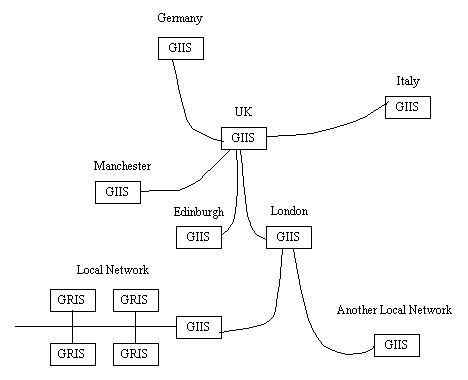


The Globus grid architecture proposes two layers from which higher-level services can be built on top of core services. This should enable the re-use of services across applications and tools such that Storage Request Brokers (SRB) can access data which can be used on an application wide level.
The research and design of the Globus project has lead to the development of a GIIS, formally the Metacomputing Directory Service (MDS) that consists of a LDAP representation in which directory structures, data representations and APIs are defined.
The discussion of a directory service will be reference in this paper in LDAP format and terminology, however, should be just as applicable in GRIS and GIIS format.
In order for a 'consumer' to find out about the network condition to a 'producer' [GridMonArch], it is proposed that a central directory service be implemented. In our model, this is presented as the LDAP engine from which a producer (i.e. the local machine containing a GRIS) will store and publish 'event' information that a consumer will receive and use. The information from these local LDAP/GRIS servers would then be updated on a local GIIS server that would communicate with other GIIS servers in order to supply the metric.
Currently, under the DATAGRID networking context, it is proposed that information should be stored on each machine on a GRIS. Within each clique a GIIS server is implemented which polls information from the GRIS servers assigned to its clique. This GIIS server would then communicate with other GIIS servers. The hierarchy of the GIIS structure is proposed as follows,

Figure 1: Proposed structure of GRIS/GIIS relationship.
As such, by only having GIIS servers at each clique communicating with other GIIS servers, we alleviate the O(n2) problem when we monitor performance from every endnode to endnode. By using geographical assignment of GIIS servers to towns/cities and countries, we only perform (possibly resource intensive) tests between the GIIS servers and hence lower the impact of network monitoring. As such, 'town GIIS' will have to communicate with a 'country GIIS' that is nominated. This 'country GIIS' will then communicate with other countries on the GRID network, also via a nominated 'country GIIS'. As such network-monitoring measurements will only be conducted between elected GIIS servers and not all individual nodes that are connected to that server.
Implementations currently use GRIS servers that also act as GIIS servers. However, this may pose problems as the machine may become heavily overload resulting in poor performance. This is especially true if the server has to gather information from many servers at once. It may be better to have dedicated GIIS servers at each location.
Within the Globus Toolkit, the information infrastructure
is handled by MDS-2 [9]. This service provides a configurable information
provider component called a Grid Resource Information Service (GRIS) and
a configurable aggregate directory component called a Grid Index Information
Service (GIIS). These components interact with each other and higher-level
services (or users) using two basic protocols: a soft-state registration
protocol for identifying entities participating in the information service,
and an inquiry protocol for retrieval of information about those entities.
In brief, a GRIS uses the registration protocol to notify a GIIS (or other
higher-level service) of its existence; a GIIS uses the inquiry protocol
to obtain information from the known to that provider, which it merges
into an aggregate view. This is shown in Figure 5.
Any information provided by a sensor, or information provider, can be
used as part of this framework by communicating to a GRIS using a well-defined
API. The GRIS and GIIS use the Lightweight Directory Access Protocol (LDAP)
[25]. They publish information in LDIF and categorize it under different
object classes (comprising multiple attributes and their associated values)
as part of the defined schema.
Links
{NONE}
| Wed, 23 July, 2003 13:07 |
Room D14, High Energy Particle Physics, Dept. of Physics & Astronomy, UCL, Gower St, London, WC1E 6BT